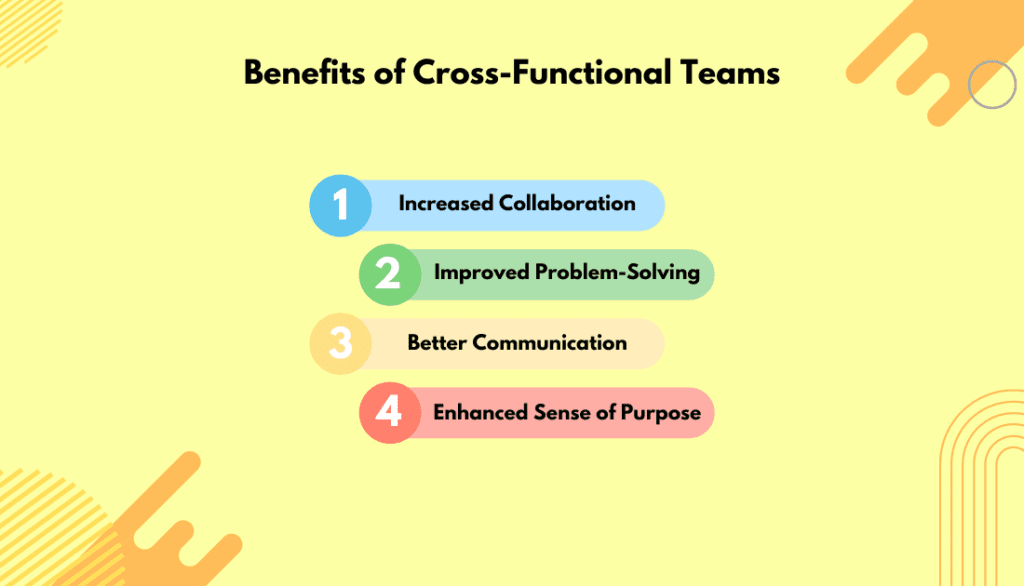If you are looking to improve your business operations, then cross-functional team collaboration is something you should consider. A cross-functional team is a group of individuals from different departments or areas of expertise who come together to work on a common goal or project.
These teams are becoming increasingly popular in businesses due to the numerous benefits they offer. One such benefit is improved communication and idea sharing among team members.
When individuals from different departments work together, they bring their unique perspectives and ideas to the table. This diversity leads to more creative solutions and better decision-making processes.
In this article, we will explore ”which of the following would be a benefit of a cross-functional team?”, so that you can understand why cross functional teams benefits for your own business needs.
The Power of Cross-Team Collaboration: Driving Success through Shared Expertise

Cross-team collaboration plays a crucial role in achieving organizational success. Apply the collective power of diverse perspectives, skills, and knowledge effectively. Then, your team can work together to accomplish common goals.
Understanding Cross Functional Team Collaboration
Cross-team collaboration involves bringing together individuals from different functional areas to collaborate on projects or tasks. These cross-functional teams typically comprise professionals with varying expertise, such as marketing specialists, engineers, designers, developers, and others.
With the strengths and knowledge of each team member, cross-functional teams can achieve more comprehensive and innovative results compared to individual efforts.
Example: Imagine a software development project where a cross-functional team includes developers, UX designers, and QA testers. Through collaboration, they combine their expertise to create a user-friendly and high-quality software product.
Breaking Down Organizational Silos
One of the key benefits of cross functional teams collaboration is its ability to break down silos within organizations. Silos often develop when different departments or teams work in isolation, hindering effective communication and cooperation.
Cross-functional teams bridge these gaps, fostering open communication and collaboration across departments.
Example: In a company, the marketing team and the product development team may have different goals and perspectives. Through cross-team collaboration, these teams can align their efforts, share insights, and work together to create a cohesive marketing strategy for a new product launch.
The Role of Collaboration
Collaboration lies at the heart of cross-functional teams. Effective collaboration involves freely sharing information, providing constructive feedback, and supporting one another throughout the entire project.
This open-mindedness creates an environment where ideas flow freely, regardless of job titles or departmental affiliations.
Example: Within a cross-functional team working on a new product design, collaboration involves designers sharing their concepts with engineers who provide feedback on feasibility. This iterative process helps refine the design and ensures the final product meets both functional and aesthetic requirements.
Which of the Following Would be Benefits of Cross-Functional Team?

If you’re looking to improve your team’s performance, the benefits of a cross functional team collaboration can offer some significant well-being. You’ll gain a better insight into their expertise and perspectives collaborating with people from other departments, .
This can help engage employees and spur innovative ideas, while also exercising communication skills and developing management skills. So if you want to create a more effective team, consider the advantages of cross-functional collaboration.
1. Driving Innovation and Collaboration
Cross-functional teams bring together experts from different fields to work collaboratively on projects. This approach offers several advantages, including gaining unique insights, fostering creativity, improving decision-making, and enhancing communication and collaboration skills.
Unique Perspectives and Experiences:
- In a cross-functional team, diverse skill sets are brought together.
- Each team member contributes their own perspective and experiences from their respective fields.
- This diversity of thought allows the team to see things in new ways and approach problems from different angles.
Creative Solutions and Better Decision-Making:
- The combination of various expertise leads to more creative solutions.
- Approaching problems from different angles enhances the team’s decision-making capabilities.
- The cross-pollination of ideas and perspectives helps in identifying innovative solutions.
Improved Communication Skills:
- Collaboration across functions encourages learning about each other’s areas of expertise.
- Shared language and common goals are developed, facilitating effective teamwork.
- Breaking down departmental silos fosters trust and understanding among team members.
Collaborative Environment and Organizational Success:
- Cross-functional teams work towards a common goal: creating innovative solutions.
- The collaborative environment promotes teamwork and mutual support.
- By driving success for the organization as a whole, cross-functional teams contribute to overall growth and achievement.
Benefits of cross functional teams offer a range of advantages, including gaining diverse insights, fostering creativity, improving decision-making, enhancing communication skills, and creating a collaborative environment. Organizations that embrace cross-functional teamwork can unlock the potential for innovation and achieve greater success.
2. Boosting Employee Engagement

Creating cross-functional teams comprising individuals from different departments can significantly impact employee engagement and contribute to the success of an organization. These teams offer numerous benefits, including increased collaboration, improved problem-solving, better communication, and an enhanced sense of purpose.
Here are some benefits of cross-functional teams for employee engagement.
Increased Collaboration:
- Working with diverse backgrounds and skill sets leads to the generation of fresh ideas and new perspectives.
- Collaboration among team members from different departments fosters a sense of unity and teamwork.
Improved Problem-Solving:
- Cross-functional teams leverage diverse experiences and knowledge bases, enabling them to tackle complex problems more efficiently.
- Varied perspectives contribute to comprehensive problem analysis and innovative solutions.
Better Communication:
- Cross-functional teams require effective communication across departments, promoting stronger relationships among employees.
- Enhanced communication skills facilitate smoother coordination and understanding between team members.
Enhanced Sense of Purpose:
- Working on a cross-functional team provides employees with a deeper understanding of how their work contributes to the organization’s overall goals.
- This increased awareness cultivates a sense of purpose, motivating employees and boosting their engagement levels.
Building cross-functional teams is a powerful approach to foster employee engagement. By assembling teams with diverse skills and experiences, organizations can benefit from improved collaboration, problem-solving capabilities, communication skills, and a heightened sense of purpose among their employees.
This, in turn, contributes to a more engaged workforce and overall organizational success.
3. Spurring innovative ideas
Cross-functional teams bring together individuals from different departments, fostering a diverse and enriching work environment. This collaboration sparks innovative ideas and encourages risk-taking, ultimately leading to enhanced productivity and learning opportunities. Let’s explore the benefits of cross-functional teams in detail.
Brings about Creative Ideas:
- Diverse backgrounds and perspectives in a cross-functional team enable the pooling of ideas, leading to new and innovative solutions.
- Combining different skill sets sparks creativity and encourages thinking outside the box.
Encourages Risk-Taking:
- Cross-functional teams promote new ways of thinking, allowing team members to take calculated risks.
- Embracing smart mistakes and learning from them leads to breakthroughs and progress.
Boosts Productivity:
- Collaboration within cross-functional teams aligns everyone towards a common goal, resulting in increased productivity.
- The collective effort and shared expertise streamline processes and drive efficiency.
Fosters Learning Opportunities:
- Working with individuals from different departments provides valuable knowledge sharing and learning opportunities.
- Exposure to diverse perspectives enhances personal growth and development.
Creating cross-functional teams yields numerous benefits, including spurring innovative ideas, encouraging risk-taking, boosting productivity, and fostering learning opportunities. By leveraging the diverse backgrounds and perspectives of team members, organizations can differentiate themselves from their competitors and achieve remarkable success through groundbreaking innovations.
4. Enhancing Communication Skills through Cross-Functional Teams

Cross-functional teams offer numerous benefits, including the generation of innovative ideas. However, another advantage worth exploring is the opportunity to exercise and improve communication skills.
Working with diverse team members from different departments and backgrounds presents challenges that can ultimately contribute to enhancing communication abilities.
Fostering Effective Collaboration
Collaboration lies at the core of cross-functional teams, and successful collaboration hinges on effective communication. When individuals with varying communication styles come together, it necessitates adapting one’s own approach and finding common ground.
This not only benefits the current project but also equips team members with valuable skills for future collaborations.
Unlocking Constructive Feedback and Understanding Diversity
Within cross-functional teams, discussions involving constructive feedback and addressing diversity issues play a crucial role in fostering overall improved communication strategies for the organization.
By openly discussing and understanding diverse perspectives, team members can develop a deeper awareness of communication barriers and implement effective strategies to overcome them.
Embracing Growth Opportunities
Rather than avoiding cross-functional teams due to potential communication hurdles, individuals should embrace them as an opportunity for personal growth as collaborators.
Engaging in cross-functional teams provides a platform to exercise and refine communication skills, ultimately enhancing one’s ability to effectively convey ideas, resolve conflicts, and build relationships within a diverse team setting.
Cross-functional teams offer more than just innovative thinking; they provide a valuable opportunity to exercise and strengthen communication skills. By embracing the challenges presented within diverse teams, individuals can adapt their communication approaches, foster collaboration, and address diversity issues.
5. Developing Management Skills in Cross-Functional Teams
Working with a cross-functional team requires honing management skills to navigate diverse backgrounds and work styles. While it can be challenging, managing such teams offers significant benefits for both team members and the organization as a whole.

Here are the advantages of developing management skills within a cross-functional team context.
Promoting Collaboration and Knowledge Sharing
Cross-functional teams bring together individuals with diverse skill sets and expertise, fostering collaboration and facilitating the sharing of knowledge. This exchange of ideas leads to increased teamwork and innovation.
Enhancing Problem-Solving Capabilities
By incorporating multiple perspectives, cross-functional teams become proficient at identifying potential problems and devising creative solutions. The varied backgrounds and experiences within the team contribute to a more comprehensive problem-solving approach.
Facilitating Informed Decision-Making
Cross-functional teams have access to a broader range of information compared to traditional teams. This wealth of knowledge leads to better-informed decision-making, as decisions are based on a comprehensive understanding of various aspects and viewpoints.
Stimulating Innovation
The diversity of viewpoints within cross-functional teams often sparks the generation of innovative ideas. The amalgamation of different perspectives and expertise encourages out-of-the-box thinking, resulting in unique and inventive solutions.
Cultivating Adaptability and Flexibility
Cross-functional teams, due to their diverse skill sets and experiences, exhibit greater flexibility in adapting to changing circumstances. This agility enables them to respond swiftly and effectively to evolving situations, ensuring continued progress.
6. Leadership Opportunities in Cross-Functional Teams
Working within a cross-functional team provides individuals with the unique advantage of assuming leadership roles. This dynamic allows team members from various departments to step up and infuse new energy into projects.
This not only fosters the development of management skills but also promotes collaboration and innovation within the team.
Leading a Diverse Group
Being in a leadership role within a cross-functional team grants individuals the opportunity to gain experience in leading a diverse group of individuals with distinct skill sets and backgrounds.
This exposure cultivates a broader perspective and enhances leadership capabilities in managing and motivating a multifaceted team.
Showcasing Strengths and Contributions
Assuming leadership within a cross-functional team enables individuals to showcase their strengths and make meaningful contributions to the project’s success.
Each team member can leverage their expertise and unique skill set, fostering a collaborative environment where diverse talents are valued and utilized.
Facilitating Learning and Collaboration
Cross-functional teams encourage a culture of learning, where team members can share knowledge and learn from one another’s experiences. In a leadership role, individuals can promote collaboration, ensuring that team members effectively communicate, exchange ideas, and collectively solve problems.
This collaborative atmosphere nurtures efficient problem-solving and informed decision-making.
7. Embracing Diversity: Breaking Stereotypes and Harnessing Innovation
Embracing diversity within teams provides an opportunity to challenge stereotypes and unlock new avenues for innovation and understanding. Cross-functional collaborations involving individuals from diverse backgrounds bring forth a wealth of perspectives and experiences.

This inclusive environment, characterized by shared goals, fosters mutual understanding, respect, and unleashes the potential for breakthrough ideas.
Enriching Work through Diverse Perspectives
A key advantage of cross-functional teams is the integration of individuals with varying ages, backgrounds, and perspectives. This diversity contributes to enriching their work by incorporating a wide range of viewpoints.
By bringing together people from different disciplines, teams can tap into a pool of unique insights and ideas, leading to greater innovation and problem-solving capabilities.
Learning from Each Other’s Strengths
Cross-functional teams offer the opportunity for members to learn from each other’s strengths. When individuals from tech and non-tech teams collaborate, they gain a deeper understanding of each other’s contributions and leverage their respective expertise.
This mutual understanding breaks down stereotypes and creates a symbiotic relationship that benefits both individuals and the business as a whole.
Unleashing Innovation for Competitive Advantage
The involvement of a diverse group of individuals in cross-functional collaboration fosters a climate of innovation. Through the combination of different perspectives, backgrounds, and expertise, these teams generate fresh ideas and approaches that propel the project forward.
In today’s competitive market, the ability to harness diverse thinking is crucial for businesses aiming to stay ahead and deliver unique solutions.
8. Building Team Spirit in Cross-Functional Teams
To foster collaboration within your team, it is vital to cultivate a sense of unity and belonging through team-building activities and open communication channels. Cross-functional teams provide a unique opportunity for members to learn from each other and build camaraderie despite their diverse backgrounds.
By promoting cooperation and embracing diversity, teams can break down stereotypes and enhance collaboration.
Learning from Each Other and Embracing Diversity
One of the advantages of cross-functional teams is the chance for members to learn from each other’s expertise and backgrounds. Encouraging collaboration between different units not only expands knowledge but also promotes understanding and appreciation for diversity.
By leveraging the diverse perspectives and skills within the team, a richer collaborative environment can be established.
Cultivating Ongoing Relationships with Stakeholders
Building team spirit goes beyond internal dynamics; it also involves developing strong relationships with stakeholders.
Investing in connections outside of work hours or providing opportunities for team members to collaborate on projects beyond their usual scope fosters a supportive environment. This sense of support and respect boosts morale and productivity within the team.
Capitalizing on Diversity for Creativity and Innovation
By nurturing relationships within the team, cross-functional teams can tap into the range of backgrounds and skill sets present. This diversity becomes a catalyst for creativity in problem-solving and innovation in project outcomes.
When team members feel valued and respected, they are more likely to contribute their unique perspectives, leading to novel and effective solutions.
Conclusion
So, there you have it! Cross-functional teams offer a multitude of benefits that can greatly improve the success and productivity of your organization. By bringing together individuals from different departments and backgrounds, you can create a diverse group of experts who can approach problems with unique perspectives and solutions.
If you’re interested in availing the benefits of cross-functional team firsthand, consider trying Onethread. Onethread is a cutting-edge platform that facilitates seamless collaboration and communication among team members from various departments.
With its user-friendly interface and robust features, Onethread can help your organization unlock its full potential. Don’t miss out on the opportunity to boost your team’s performance and take your company to new heights.
Get started with Onethread today!
Frequently Asked Questions
What Are Some Common Challenges That Cross-Functional Teams Face?
You may encounter various issues such as communication barriers, conflicting priorities, and difficulty in decision-making when working with a cross-functional team. It requires effective collaboration and coordination to overcome these challenges and succeed.
How Can A Company Foster A Culture That Supports Cross-Functional Collaboration?
To foster a culture that supports cross-functional collaboration, encourage open communication and teamwork across departments. Provide opportunities for cross-training and celebrate successful collaborations to reinforce the value of working together.
What Types Of Projects Or Initiatives Are Best Suited For Cross-Functional Teams?
To determine what types of projects or initiatives are best suited for cross-functional teams, consider the complexity and scope of the project. Larger initiatives with multiple components that require diverse expertise are ideal for cross-functional collaboration.
How Can Cross-Functional Teams Help Improve Communication And Decision-Making Within A Company?
Cross-functional teams can improve communication and decision-making in your company by bringing together individuals with diverse skill sets, perspectives, and knowledge. This leads to more creative solutions and a better understanding of different departments’ goals and needs.
Are There Any Potential Drawbacks Or Risks Associated With Cross-Functional Teams That Companies Should Be Aware Of?
You should be aware of potential drawbacks and risks when implementing cross-functional teams. These may include conflicting goals, communication difficulties or lack of accountability. However, with proper management, the benefits can outweigh the risks.
